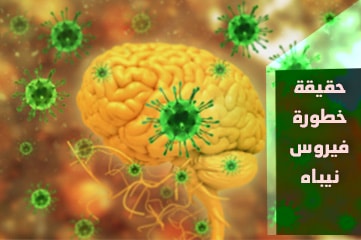The reality of the danger of the Nipah virus
Prepared by/ Muhammad Ali Adwan
The World Health Organization (WHO) noted on its website in the context of listing the reality of the seriousness of the Nipah virus, as it was considered one of the most dangerous sources of epidemics for humanity that require an “urgent response”.
The British newspaper “The Guardian” said that the epidemic “Nipah” is one of the ten most infectious and lethal epidemics in the world, Major pharmaceutical companies are not as prepared to face it as they did with the coronavirus pandemic.
About the Nipah virus and the most prominent countries in which it spreads:
This virus first appeared in Malaysia in 1998 on Peninsular Malaysia in pig farms where more than 600 cases were detected, 1999. Then it moved and spread in neighboring countries of Malaysia, namely Singapore, Bangladesh and India, It caused many deaths, the highest in Bangladesh.
The Nipah virus was isolated in 1999.
The World Health Organization stated that this epidemic is transmitted through pigs and their meat and can be transmitted through humans and many foods. Including vegetables and fruits.
What is the danger of Nipah virus:
1- According to the World Health Organization, Nipah virus is a zoonotic virus (transmitted from animals and birds to humans) and can also be transmitted through contaminated food or directly between humans.
2. Nipah virus infection in humans causes a range of clinical symptoms, They range from asymptomatic infections to acute respiratory infections and fatal encephalitis.
3- The death rate of cases is estimated at about 40% to 75%. This rate can vary by outbreak depending on local epidemiological surveillance and clinical management capacities.
4- Nipah virus can be transmitted to humans from animals (such as bats or pigs) or contaminated food and can also be transmitted directly from person to person.
5- Fruit bats of the family “Pteropodidae” are the natural host of the Nipah virus.
6- There is no treatment or vaccine available for humans or animals to confront the Nipah virus.
7- The treatment available to humans is supportive care.
8. The World Health Organization has identified Nipah virus as a priority disease for WHO for research and development.
The virus can also cause serious illness in animals such as pigs, the WHO said.
According to the World Health Organization , the most prominent symptoms of the Nipah virus:
1- Fever
2- Headache.
3-Muscle pain
4- Vomiting.
5- Sore throat.
6. The condition may develop into dizziness or fainting.
7- Signs of acute inflammation of the brain.
8. Pneumonia and breathing problems.
Follow up on the reality of the seriousness of the Nipah virus
How Nipah virus is transmitted:
During the first recognized deployment in Malaysia, which also affected Singapore, Most human infections resulted from direct contact with sick pigs or their contaminated tissues.
It is believed that transmission occurred by unprotected exposure to pig secretions, or unprotected contact with the tissues of a sick animal, According to the Health Organization.
In subsequent outbreaks in Bangladesh and India, Consumption of fruit or fruit products (as an example: raw palm juice) contaminated with urine, or saliva from fruit bats that are infected, It is the most likely source of infection.
Human-to-human transmission of Nipah virus has also been reported between family members and caregivers of infected patients.
On Sunday, January 31, 2021, China denied the allegations reported by the media that it was responsible for the deadly virus, This came in a statement by the Chinese embassy in Cairo indicated that this virus is present in South Asia and not in China specifically. He stressed that there is no scientific evidence to support these claims.







